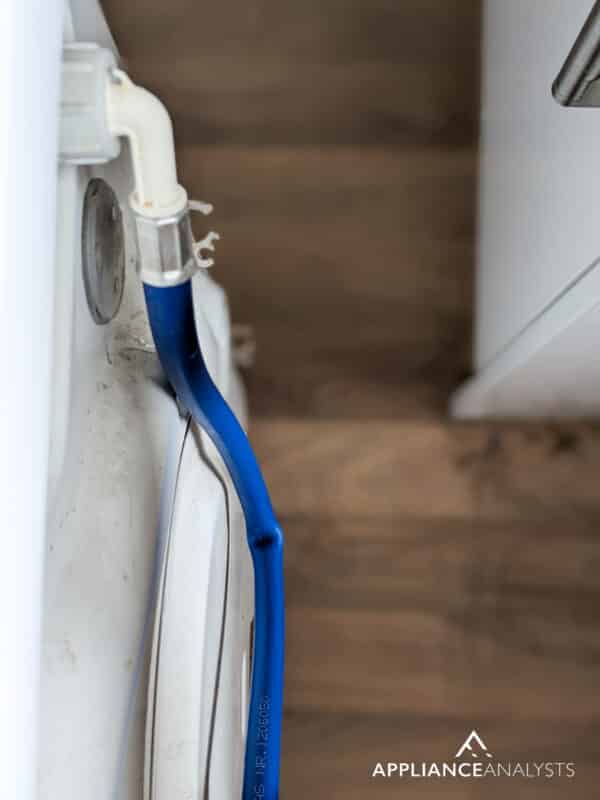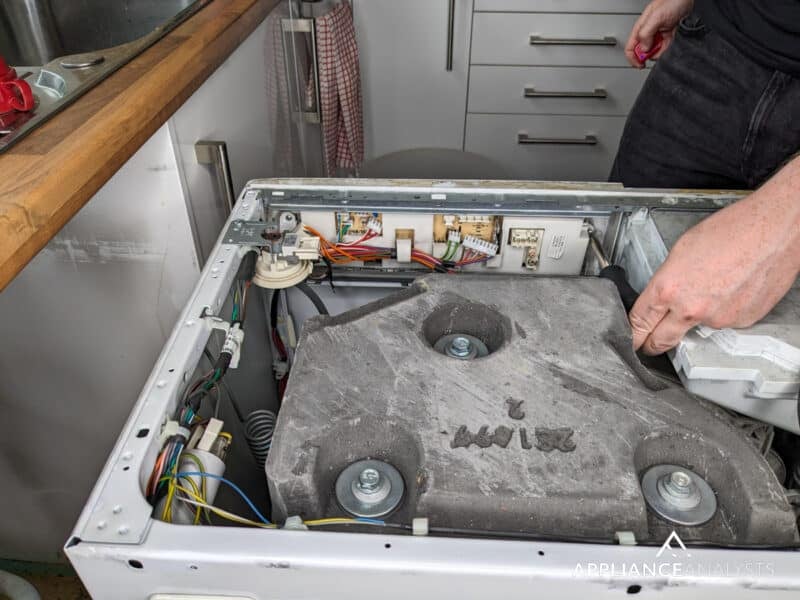We've independently reviewed this article to make sure it's as accurate as we can make it.
To find out more about our article creation and review process, check out our editorial guidelines.
Is your washer filling too slowly?
I’ve been there too! Dealing with a malfunctioning washing machine can be quite frustrating, especially when you’ve got a pile of dirty laundry to wash.
Luckily, you’ve come to the right place to fix the issue.
If your washing machine fills too slowly, check the water pressure and the hot and cold water supply. Then, inspect the hoses and clean the inlet filters. Examining the water inlet valve, pressure switch, and main control board is also important.
Read on to learn how to fix the water flow issues in your washer!
Washer Fills Too Slowly? Try These 7 Fixes
In this section, I’ll explain why your washing machine is filling up with water slowly and walk you through different troubleshooting techniques that will help you forget all about the issue today.
Are you ready? Let’s get started!
#1 Check the Water Pressure
When I see a washing machine filling too slowly, I always check the water pressure.
You see, if your washer doesn’t have adequate water pressure, you can experience different issues, such as longer cycle times, ineffective cleaning, and, of course, slow filling.
Some modern washing machines will display an error code if there’s an issue with water pressure. However, if you have an older washer or don’t see an error code, you can still determine if water pressure is the reason why the unit is filling slowly.
Please follow these simple instructions to check the water pressure:
- Turn off the water supply to the washing machine and unscrew the hoses. Be ready for some water to spill out. Try placing some towels or a bucket on the floor to catch any water spills.
- Open the door or lid on the washer and stick the hoses inside the drum.
- Turn on the water supply and check the pressure. If it’s weak, then there’s an issue with the water pressure in your home or on that particular line. In such cases, I find it best to call a plumber.
#2 Examine the Hot and Cold Water Supply
If your washer takes too long to fill, it’s crucial to check the water valves.
Sometimes, water valves can be partially closed without us even noticing. So, please ensure the hot and cold water supply valves are fully open.
If the water valves are fully open, it’s time to check the hot and cold water supply individually. In my opinion, the easiest way to do so is by running a cycle that only uses cold water. You can select a rinse cycle or the “Delicates” setting. Then, check the water flow speed.
Once you’ve checked the cold water supply, select a “Sanitize” or “Tub Clean” cycle, as these settings only use hot water. Check if the hot water is filling more quickly than the cold water (or vice versa). If it is, you must inspect the filter, hose, and water inlet valve. Please keep reading to learn how to do it.
#3 Inspect the Hoses
In my experience, damaged hoses can explain why your washing machine is filling too slowly.
You see, the hoses connect your washer to the water supply in your home. So, if they become damaged, they can lead to restricted water flow, and explain why your washer is taking too long to fill up.
Don’t worry, though. Inspecting the water hoses in your washer is very simple. You’ll just need to:
- Unplug your washing machine from its power source or turn it off at the circuit breaker.
- Carefully move your washing machine to access the hoses.
- Turn off the water supply valves.
- Unplug the hoses from the back of the washing machine. If needed, use some pliers. I recommend placing a towel or bucket underneath to catch any water spills.
- Examine the hoses. Look for any signs of damage, such as cracks, holes, kinks, or rust on the hose fittings.
If you notice the water hoses are damaged, please replace them with new, compatible ones.

If you want to get any replacement part – or see how much one would cost – click to enter your model number in the search bar below. Our partners at AppliancePartsPros stock almost every part with free guides on how to install them.

#4 Clean the Filters
My usual advice when fixing a washer that fills slowly is to clean the screen filters.
The filters are located where the water supply hoses connect to the washer and are responsible for catching debris, sediment, and other particles from the water supply before it enters the unit. Over time, the screen filters can become clogged, which can explain the slow water fill issue.
Here’s how to clean the inlet screen filters:
- Unplug the washing machine from its power source to prevent electrical hazards. You can also turn it off at the circuit breaker.
- Turn off the water supply and carefully disconnect the hoses from the washing machine. Remember that you’ll probably need some pliers. I recommend keeping a bucket or a towel to catch any water spills.
- Locate the inlet screen filters and remove them with a pair of needle-nose pliers.
- Take a closer look at the filters and rinse them under running water. Then, gently scrub them until they’re clean. If needed, use a mild detergent.
- Once the filters are clean, place them back into the inlets.
- Reattach the water hoses, turn the water supply back on, and plug your washer back into the power outlet.
Note: If you notice that the filters are damaged or broken, you’ll need to replace them.

Once you’ve cleaned the inlet filters, please try running a cycle again. If you’re still struggling with slow fill times, keep reading.
#5 Examine the Water Inlet Valve
If you’ve tried all the fixes above, but your washer is still filling too slowly, you’ll need to check the water inlet valve.
The water inlet valve is one of the most important components in your washing machine, as it opens and closes to control water flow into the unit. Unfortunately, if the water valve is not opening fully or partially closed, it can reduce the water flow and lead to slow fill times.
In such cases, you’ll need to access the water inlet valve and test it with a multimeter. Here’s how to do it:
- Unplug your washing machine from the power outlet, turn off the water supply, and disconnect the water hoses. Remember to place a bucket or towel on the floor to catch any water spills from the hoses.
- Open the access panel to reach the water inlet valve (typically located at the back of the washer). Don’t forget to read the manufacturer’s manual for detailed instructions on accessing the valve.
- Set your multimeter to the ohms or resistance setting and locate the solenoids, which are the two small metal pieces where the wires connect.
- Disconnect the wires and touch one probe to one terminal and the other probe to the other terminal of the solenoid.
- If the reading indicates zero resistance or infinity, then the water valve is faulty and needs to be replaced.

New water inlet valves typically cost between $30 and $100 and are very easy to install. However, if you’re uncomfortable testing or replacing the water inlet valve yourself, it’s best to call a professional, which will cost you between $150 and $300 for parts and labor.
#6 Check the Pressure Switch
I’ve seen that a malfunctioning pressure switch can also be the reason why your washer is filling slowly.
You see, the pressure switch is responsible for monitoring the water level. It communicates with the control system to close the water inlet valve once the desider water level has been reached. As you can imagine, if the pressure switch is faulty, it can send incorrect signals, leading to a slower filling process.
To solve the issue, you’ll need to access the pressure switch, which is typically located in the top panel or rear upper part. But please refer to the manufacturer’s manual for specific instructions.
Once you’ve accessed the pressure switch, please test it with a multimeter. You should get a reading close to “0” ohms of resistance (or the one recommended by the manufacturer). If you get a different reading, please replace the pressure switch with a new one.
#7 Inspect the Main Control Board
If you’re still struggling with the slow filling issue on your washing machine, it’s time for us to check the main control board.
You can think of the control board as your washer’s brain. It receives inputs from different components and manages various functions, such as water filling. Unfortunately, when the control board malfunctions, it can lead to all sorts of problems when using your washer. These issues can range from inconsistent water levels and error codes to spinning troubles and unusual noises.

Please keep in mind that replacing the control board can be very challenging and expensive. Therefore, when the control board is faulty, it’s crucial to consider the washer’s age. If your machine is over 12 years old, it’s probably best to replace the entire unit.
If your washing machine is relatively new and you suspect the control board is faulty, please review the warranty documentation that came with your washer. If your washing machine is still under warranty, it’s important to get in touch with the manufacturer or retailer.
Fixing Slow Water Fill Issues in Your Washer
That about covers it! Hopefully, now you know how to fix the slow-filling issue on your washing machine.
Remember that you’ll need to check the water pressure, examine the hot and cold water supply, inspect the hoses, and clean the inlet filters to ensure proper water flow.
However, if the issue persists, don’t forget to test the water inlet valve, check the pressure switch, and examine the main control board. Replace any components if necessary.
Thank you so much for taking the time to read this article. If you ever experience a different issue while using your washing machine or any other appliance, please check out our site.
Have a wonderful day!









